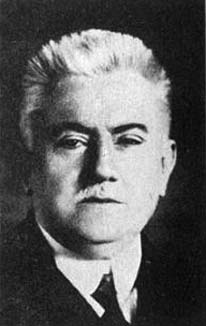


 تاريخ الرياضيات
تاريخ الرياضيات
 الرياضيات في الحضارات المختلفة
الرياضيات في الحضارات المختلفة 
 الرياضيات المتقطعة
الرياضيات المتقطعة
 الجبر
الجبر
 الهندسة
الهندسة 
 المعادلات التفاضلية و التكاملية
المعادلات التفاضلية و التكاملية 
 التحليل
التحليل
 علماء الرياضيات
علماء الرياضيات |
Read More
Date: 17-3-2017
Date: 25-3-2017
Date: 30-3-2017
|
Died: 26 March 1933 in Budapest, Hungary

József Kürschák's mother was Jozefa Teller and his father was András Kürschák, a manual worker who died when József was six years old. After the death of his father, József was brought up in Budapest by his mother. It is correct to say that József, although born in Buda, was brought up in Budapest after the death of his father since Budapest was created by the unification of Buda, Obuda and Pest in 1872. Kürschák attended secondary school in the flourishing city that became not only the capital of Hungary but also a major centre for industry, trade, communications, and architecture. Most importantly for the young boy, he was growing up in a city which was a centre for education, and for intellectual and artistic life.
Kürschák entered the Technical University of Budapest in 1881 and graduated in 1886 with qualifications to teach mathematics and physics in secondary schools. He then taught at a school in Roznyo, Slovakia, for two years before returning to the Technical University of Budapest to undertake research. He received his doctorate in 1890 and then taught in Budapest, at the Technical University, for the whole of his career. He was appointed in 1891 and successively promoted, achieving the rank of professor in 1900.
In [2] the authors describe a paper by Kürschák written in 1898 in which a regular dodecagon inscribed in a unit circle is investigated. A trigonometric argument can be used to show that its area of the dodecagon is 3 but Kürschák gives a purely geometric proof. He proves that the dodecagon can be dissected into a set of triangles which can be rearranged so as to fill three squares with sides having length 1. Kürschák's tile, which occurs in the title of [2], is constructed as follows. Start with a square and construct an equilateral triangle drawn inwards on each side. A regular dodecagon has the following 12 points as vertices: the 8 intersections of the corresponding sides of adjacent equilateral triangles and the 4 mid-points of the sides of the new square formed by the vertices of the four triangles. In fact the first paper which Kürschák wrote was concerned with polygons. This was Über dem Kreise ein-und umgeschriebene Vielecke(1887) which investigated extremal properties of polygons inscribed in, and circumscribed about, a circle.
Another topic which Kürschák investigated was the differential equations of the calculus of variations. Papers such as Über partielle Differentialgleichungen zweiter Ordnung mit gleichen Charakteristiken (1890), Über die partielle Differentialgleichung des Problems (1894), Über die Transformation der partiellen Differentialgleichungen der Variationsrechnung (1902), and Über eine charakteristische Eigenschaft der Differentialgleichungen der Variationsrechnung (1905) are examples of his work in this area. He proved invariance of the differential equations he was considering under contact transformations. Another problem he solved in this area was to find, in his 1905 paper, necessary and sufficient conditions for [1]:-
... a second-order differential expressions to provide the equation belonging to the variation of a multiple integral.
Led to consider linear algebra in the context of the above work, he wrote a number of papers on matrices and determinants such as Über symmetrische Matrices (1904) and Ein irreduzibilitätssatz in der Theorie der symmetrischen matrizen (1921).
Kürschák's most important work, however, was in 1912 when he founded the theory of valuations. His idea was to define | x | for a rational number x as follows. Express x in lowest terms as pn(a/b) and then define | x |p = p-n. For example
| 20/11 |2 = 1/4,
| 20/11 |3 = 1,
| 20/11 |5= 1/5, and
|20 /11 |11 = 11.
The rationals are not complete with this metric and their completion is the field of p-adic numbers. Kürschák's work was inspired by earlier work of Julius König, Steinitz and Hensel. The importance of Kürschák's valuations is that they allow notions of convergence and limits be used in the theory of abstract fields and greatly enrich the topic.
Dénes König and Von Neumann were both students of Kürschák and many other famous mathematicians benefited from his teaching. Dénes König received his doctorate in 1907 for a thesis written under Kürschák's supervision. Peter writes in [4] that:-
... outstanding mathematicians such as Hunyadi, Julius König, Kürschák and Rados have contributed to the high standard of mathematical education at the Technical University [of Budapest]. Their scientific and teaching activity affected mathematical life in the whole country and laid the foundation of the internationally recognized mathematical school in Hungary.
Indeed Kürschák achieved this through his excellent teaching as well as bringing the very best out of his students. He was one of the main organisers of mathematical competitions and to honour his outstanding contributions in this area the Loránd Eötvös Mathematics Competition, started in 1925, was renamed the József Kürschák Mathematics Competition in 1949.
Kürschák was elected to the Hungarian Academy of Sciences in 1897.
Articles:



|
|
|
|
4 أسباب تجعلك تضيف الزنجبيل إلى طعامك.. تعرف عليها
|
|
|
|
|
|
|
أكبر محطة للطاقة الكهرومائية في بريطانيا تستعد للانطلاق
|
|
|
|
|
|
|
مشاتل الكفيل تزيّن مجمّع أبي الفضل العبّاس (عليه السلام) بالورد استعدادًا لحفل التخرج المركزي
|
|
|